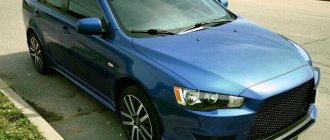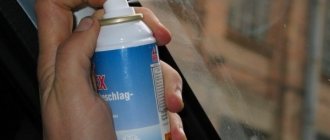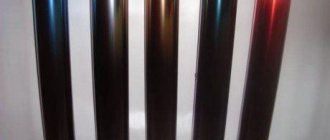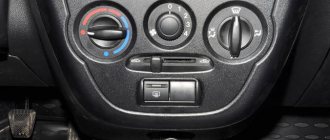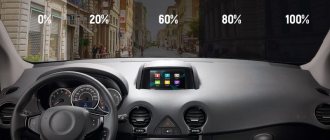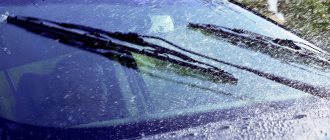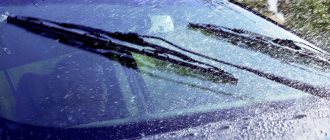Winter is a difficult period for a car owner. A car parked overnight in a parking lot or near a house freezes over and requires at least half an hour in the morning to warm up and clear snow and ice. Car windows require special attention - on a winter road you need full visibility, and they must be cleaned.
How to quickly warm up a windshield that is covered with a crust of ice? In modern cars today, “soft” glass is installed, which reduces the risk of injury to the driver in an accident, but requires very careful handling in winter. Glass surfaces can be easily scratched or damaged when cleared of ice. Therefore, heating the windshield requires the use of only gentle technologies.
What to use to remove ice from car windows
In the morning, everyone is usually in a hurry to go to work and on errands; there is often no time for long-term “gentle” heating of the windshield, and you have to warm the glass quickly. The simplest option is to turn on the heater in the cabin and direct the airflow onto the glass. This method is good in two cases: you have time to fully warm up the car, or there was no severe frost outside, and the glass was slightly frosted.
If there was severe frost and a thick crust of ice formed on the glass, short and powerful heating is dangerous - the windshield may simply crack from a sharp temperature change. Trying to melt ice with boiling water will give the same sad result.
Therefore, you need to warm up the windshield carefully, using less aggressive methods and additional equipment.
Plastic scraper and brush
If there is no heavy ice on the car glass, and the stuck snow has a more or less loose structure, you can try to remove it with a scraper and brush. An experienced driver always carries such equipment with him in the trunk in winter.
The scraper should be covered with soft plastic or thick rubber. Metal and hard plastic scrapers are excluded - you will simply scratch the glass. But even a soft scraper should be used to a minimum and very carefully. At the same time, you should start the stove to warmly (not maximally!) blow the glass from the inside and wait a little until the bottom layer of ice is slightly flooded - then the layers of ice will easily slide over the formed film of water under the action of the brush.
Important point! You can remove ice with a plastic scraper only from a clean windshield. If it's covered in dirt, you risk scratching the surface with sharp grains of sand.
Heater
To avoid mechanical damage to the windshield, it is better to use only the heater. To do this, it is better to turn on the stove when the engine is not running to prevent the glass from cracking due to strong temperature changes. Within 10-15 minutes the ice will melt and it can be cleaned off with a regular brush.
Second option: start the engine and heater to heat the interior to maximum, and direct minimal airflow onto the glass. While the engine is heating up, the glass will be blown first with cold air, and then with increasingly warmer air. At the same time, you can turn on recirculation so that the blower takes warm air from the cabin, and not cold air from the street.
There is a risk of getting a crack in the glass only if you first warm up the car engine and then direct a strong stream of hot air onto the glass. This method of heating is especially dangerous if the “lobovukha” already has old cracks from mechanical damage.
Warm water
Ice on the car window can be melted with water if you don’t have time to blow it off. This is an old proven method, but the water must be warm - no more than 50°C, and it must be poured onto the glass slowly. A thin layer of ice will quickly melt, but a thick layer will flood from below and can be scraped off with a scraper.
Never pour boiling water on the glass! With a sharp temperature change, the surface may crack, especially if it already has small mechanical cracks.
Glass defroster
Do you want to quickly solve the problem of heating your windshield and clear it of ice without mechanical damage? Use modern auto chemicals - a special glass defroster, which gives the fastest possible effect even in very severe frosts (down to -40°C).
Simply spray the defroster onto your windshield, wait a few minutes, and begin scrubbing the surfaces with a brush.
Try not to buy cheap defrosters - they are ineffective, can corrode the rubber seal on the glass, and some contain methyl alcohol, which is dangerous to humans. It’s better to spend money once and a can of high-quality defrost will last you the whole winter.
Anti-freeze
If the ice crust on the windshield is not too thick, you can clear it by turning on the windshield wipers and windshield washer. Anti-freeze, which is usually poured into the washer reservoir, has a freezing point lower than that of water, which means it will melt the ice on the glass, and then it will be easy to clean it off with wipers and a brush.
The glass washing procedure must be repeated several times to soften and melt the ice. Pre-clean the wiper blades from ice to prevent them from scratching the glass.
Alcohol
Ice from glass surfaces can be easily removed with alcohol (ethyl or isopropyl). Alcohol freezes at temperatures of -90-110°C, and behaves like an anti-freeze agent or a concentrated glass defroster, but melts ice faster.
It is better not to pour alcohol onto a thin layer of ice, but to spray it on the frosted glass. In this case, the ice will instantly begin to defrost and flow down the glass. It is better to soak a thick crust of ice with alcohol, pouring it onto the top of the “lobovukha” so that it flows down freely. The submerged and loosened crust can then be cleaned off with a scraper and brush.
You can dilute the alcohol with water to save liquid. This mixture can be used in frosts no lower than -25°C, but if the winter is not too cold, it will be quite effective.
Is your windshield freezing? We'll show you how to quickly defrost your windshield in any frost!
Hello everyone, today we will figure out how to effectively remove ice from your windshield, spending a minimum of time and effort. You will also learn how to make a car window defroster at home quite inexpensively.
Winter operation, as I already said in my previous publications, is always a test for the motorist and the car itself. If in warm weather the car had some minor defects, then with the advent of cold weather or frosts everything will manifest itself more seriously, in the form of big problems.
One of the big troubles for all motorists is dealing with snow and ice. If a car is stored outside, motorists have to deal with snow and frozen windows every day. And if snow is easily removed with a broom or brush, then with ice and icy windows everything is much more complicated.
How to prevent ice formation
If you are tired of cleaning your windshield from ice and snow every day, or you don’t have time for it, it is better to take care of glass maintenance so that there is no ice, or less ice. There are several simple and easy ways to do this.
Ventilation of the interior
After you park your car in the parking lot or near your house in the evening, open the doors for 5 minutes and let the cold air enter the cabin. If the temperature inside the car is not much higher than outside, the windows freeze less. A couple of minutes before parking, you can also turn off the heater in the cabin.
Covering glass
The old way is to cover the frontal area with a car blanket at night. In the morning, all the ice will accumulate on it, and the glass will not need to be cleaned and defrosted. To prevent the blanket from being blown away by the wind or to prevent it from being stolen, press the edges of the fabric with the front doors closed and the fabric itself with windshield wipers. Instead of a blanket, you can also use plastic film (it does not get wet and does not freeze to the glass).
Hydrophobic glass treatment
To reduce the frosting of car windows, they can be periodically treated with “anti-rain”, which creates a thin water-repellent film on the glass. Moisture does not stay on the surface and flows down, but at the same time it does not freeze into a strong ice crust and is easily cleaned off in the morning.
Wiper protection
Sometimes, in severe frost, windshield wiper blades freeze to the windshield. When they are turned on, the electric motor of the windshield wipers may fail. To avoid having to bother with the wipers in the morning, periodically treat them with silicone. It repels moisture and creates a thin waterproof film on the brushes.
Antifreeze for car windows in winter
Using windshield wipers to warm and clear ice and snow from your windshield is an effective solution. However, you should choose this type of auto chemicals very carefully: some aerosols contain substances harmful to car coatings or methyl alcohol, which is dangerous to humans.
Another thing is windshield cleaning fluids mixed with your own hands. Here you will know exactly the composition of the components and their dosage. Experienced car enthusiasts use their own windshield wipers and recommend two types of such liquids - alcohol-based and salt-based solutions.
Alcohol based glass cleaner
The solution contains alcohol, water and household dishwashing detergent (the latter component is desirable, but not required). Alcohol is mixed with water in a 2:1 ratio, after which a few drops of washing gel are dissolved in the solution, and the finished liquid is poured into a container with a sprayer. When you spray it on a frost-bitten windshield, you will get the fastest possible result - it melts instantly and is removed with a brush.
Salt based glass cleaner
If you don’t have alcohol on hand, you can add salt to the water (8-10 tablespoons of salt per 5 liters of water). The solution also needs to be poured into a container with a spray bottle. It is not as effective as an alcohol mixture, but. If you apply it to the glass and wait a few minutes, the ice will loosen and can be easily removed.
Note! It is not advisable to use a salt glass cleaner often - salt corrodes the sealing rubber and causes corrosion of metal surfaces.
In conclusion, it should be noted that driving a car with a frozen windshield in winter. A snow-covered road requires special attention and full driver visibility, so you should drive out onto the road only after the front wheel has been completely cleared.
However, glass requires careful handling, and in order to protect it from scratches and cracks, mechanical forces should be used to a minimum when removing ice from surfaces. It is better to first melt the ice with warm water, gentle airflow from the stove in the cabin, anti-freeze, alcohol, purchased or independently mixed windshield wipers.
Types of defrosters
Car enthusiasts and sellers refer to all defrosters in one word - “anti-freeze”. However, you should know that they differ in the type of impact.
There are two types of defrosters:
- Warning. These products are used to prevent the formation of ice crust. This includes products from the “anti-ice” series.
- Destroying ice. Designed to defrost and remove already formed ice crust from glass and housing, without the risk of damaging them.
To avoid misunderstandings, it is always worth clarifying what type of impact the car enthusiast has in mind in order to avoid misunderstandings and disappointment.
Car enthusiasts should know that there are also key defrosters and universal ones. Universal ones are suitable for both locks and glass.
Some car enthusiasts prefer to make a glass defroster with their own hands. However, they are generally of lower quality than factory-produced products. After removing ice with homemade compounds, stains and stains remain.
